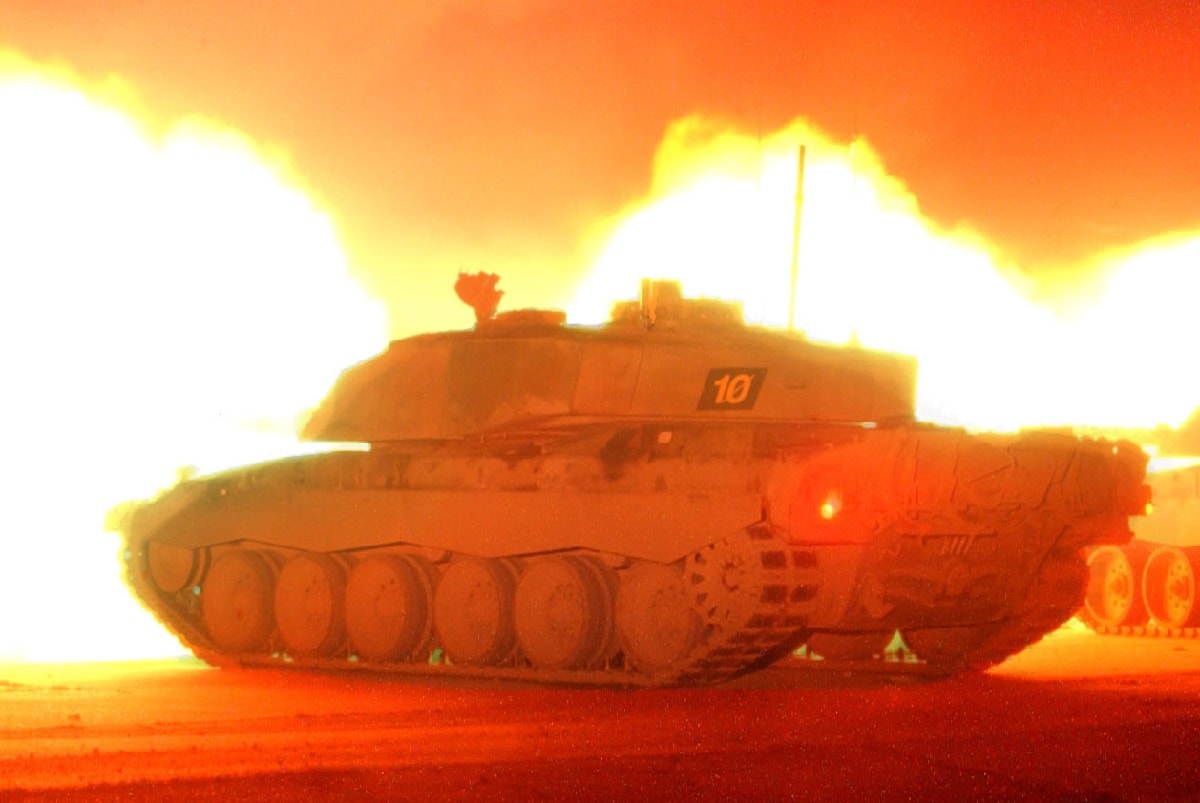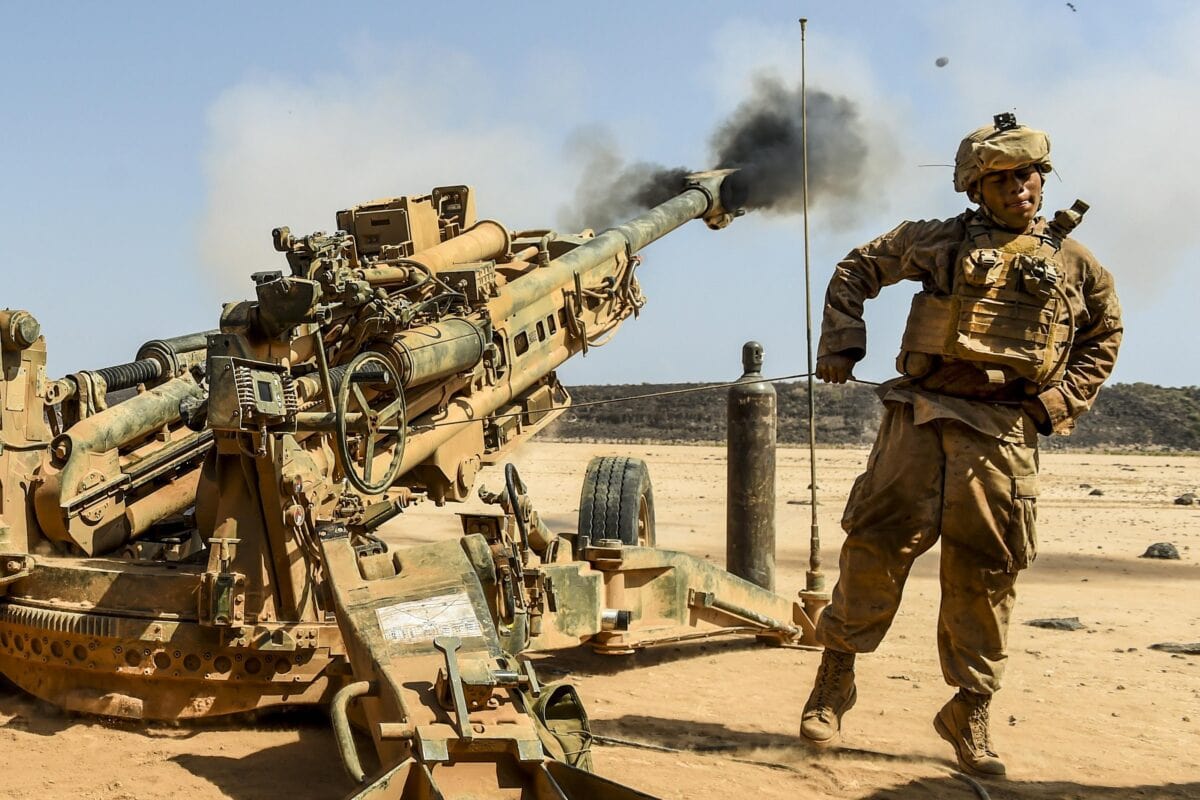Robert Farley

Three Challenger 2 main battle tanks firing their 120mm guns during a night firing exercise by the Royal Mercian and Lancastrian Yeomanry at Lulworth, Dorset.
The Ukraine War on the Ground: It is difficult to learn the right lessons from the wars of the past. It is harder still to operationalize those takeaways in any kind of useful way. It is certainly risky, then, to look for lessons about war from a conflict that is still ongoing, but we are going to try.
In this three-part series, we will endeavor to distill some lessons from the conduct of the Russia-Ukraine War to this point.
In this first part of a three-part series (you can read part II here), we will discuss the ground war in Ukraine.
Ukraine: Offensive Maneuver Hasn’t Gone Away
The war began with a spectacular Russian maneuver designed to seize Kyiv and force the Ukrainian government to capitulate. That maneuver, which also included an airborne assault, failed dramatically and led to a disordered retreat in the ensuing weeks. Over the course of that retreat, Ukrainian infantry, artillery, and aircraft picked off Russian armored vehicles seemingly at will. The advent of “Saint Javelin” opened up questions about whether the time-honored infantry-armor team could survive in a context defined by longer-ranged, more lethal infantry weapons. This evolved into discussions about whether the main battle tank, the venerable armor leader on the battlefield, has finally become obsolete.
The Ukrainian offensives in Kherson and Kharkiv, along with incessant requests from Ukraine for more and more modern tanks, should put these arguments to rest. While Ukrainian success has hinged on factors idiosyncratic to each front, both of its major advances made use of the traditional armor-infantry-artillery triad. It remains possible for a carefully structured offensive to seize territory, at least when all of the pieces work together as they should.
ARTILLERY IS STILL GOD
The fast-paced military campaigns of the 1990s and 2000s seemed to devalue the contribution of artillery. Although mobile artillery systems complemented maneuver-centric operations, airpower and standoff munitions seemed to replace what came to be regarded as the slow, plodding artillery arm.
Masses of enemy troops need not be destroyed when they can be paralyzed or encircled. Airpower, it was thought, could do the job that was once left to clumsy artillery tubes.
No more. Ukrainian and Russian artillery tubes have had a devastating effect on exposed enemy forces, and artillery has re-established its primacy of place. Grinding barrages have had an attritional impact on infantry in fortified positions, with battles in the Donbas often devolving into artillery duels. Miserable, dug-in infantry are suffering levels of devastation that would have been well understood in 1916. Mass, it seems, still has a quality all its own.
LOGISTICS AND SUPPLY
As Lawrence Freedman has pointed out, nearly every long war begins with ambitions to wage a short war. The failure of Russia’s initial offensive to seize Kyiv meant that a war nearly everyone expected to be short now has no clear endpoint. This has meant delving into stockpiles of equipment and munitions that neither side expected to use. Both Ukraine and Russia have, at times, used ammunition at an unsustainable rate.
The pace of combat has forced Russia to seek supply from Belarus, North Korea, and Iran. For its part, Ukraine has been forced to beg for equipment and ammunition from the West, much of which has already been so heavily used that it is breaking down from wear and tear rather than from direct enemy action.
Unfortunately, NATO militaries have discovered their stockpiles short on the ammunition needed to fight a high-intensity war, and they are now struggling to keep up with Ukraine’s needs.
Long story short, every country needs to prepare for the fact that its pleasantly short war might run long.
COMMUNICATIONS
One of the most important contrasts between the conduct of today’s war and the conduct of past wars involves the extensive and overlapping networks of information management on both sides. Elon Musk’s network of Starlink satellites has helped keep the Ukrainian military connected and aware of its surroundings, making it possible not only to build intricate, self-supporting defenses, but also to conduct mobile offensive operations.
For their part, the Russians suffered bitterly in the early days of the war from an incomplete communications network, with various legacy systems unable to communicate with one another, and with use of commercial technology (cellphones) often enabling successful Ukrainian artillery strikes.
Technology, of course, is not determinative. The information economy of Russian forces is much different than that of the Ukrainians. On the Russian side, the availability of drones and real-time communications has resulted in an even more hierarchical system of command and control. Remote commanders are relying on video to monitor the compliance of their own troops with orders, changing the nature of the longstanding principal-agent problem.
On the Ukrainian side, the availability of information has made possible a diffuse system of command and control that has played well against Russian weaknesses.
Ukraine War: A Return to World War I?
Altogether, the war thus far shows that we still follow the fundamentals of war established in World War I. Technologies from ballistic to electronic have yet to undo the infantry-armor-artillery triad, though they might shift the balance in one direction or another. There is no question that the armies fighting today in Ukraine are more technologically advanced than the armies that fought on the Western Front in 1917.
At the same time, there is little that an infantry or artillery captain from 1917 would find unintelligible about the fighting in the Donbas.

US Military M777 Artillery. Ukraine Now Has a Similar System.
No comments:
Post a Comment